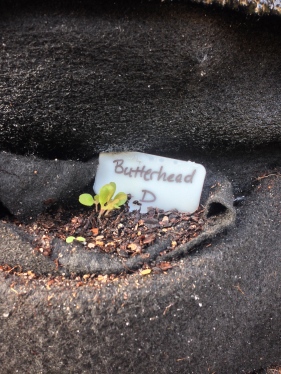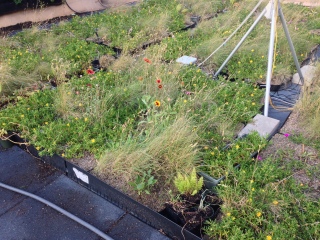Since the use of fruit and vegetable crops on one of the green roofs seemed like a good idea, my classmates and I also thought it would be interesting to see how such crops would perform on a living wall. As with the green roof, various types and varieties of crops were used, as well as different growing techniques. Due to the living wall system consisting of pockets, all transplanted plants had to be wrapped in cloths and then inserted into each pocket. For plants that were directly seeded, we prepared pockets of soil in advance and then inserted the seeds by hand.
Unlike the green roof that was planted prior to this, a few of the plants on the wall do not seem to show much promise and water intake appears to be an issue. Weekly observations have indicated a slight decline in many of the plant species we selected, particularly some varieties of mint. Should these conditions continue, it is likely that many of the plants will have to be replaced. However, since these projects are primarily for research purposes, any results or data collected are helpful in understanding how these systems work and how our current methods and techniques can be improved.




 While some of the plants were simply transplanted, others were directly seeded. This was done to determine which method would yield better results. Weekly observations have indicated that both methods are successful and many of the plants have begun to show promise. If these results continue, we may actually be able to harvest some of the crops within the next couple of months or so.
While some of the plants were simply transplanted, others were directly seeded. This was done to determine which method would yield better results. Weekly observations have indicated that both methods are successful and many of the plants have begun to show promise. If these results continue, we may actually be able to harvest some of the crops within the next couple of months or so.

